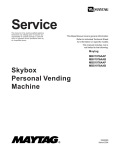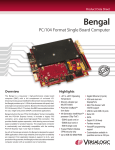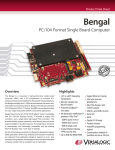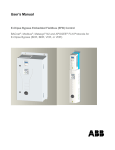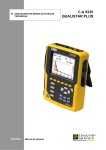Download E104-MPE user manual - Diamond Systems Corporation
Transcript
E104-MPE-04 PCI/104-Express Quad PCIe MiniCard Carrier User Manual Revision A.00 Revision Date Comment A.00 3/30/15 Initial Release FOR TECHNICAL SUPPORT PLEASE CONTACT: [email protected] March 2015 Copyright 2015 Diamond Systems Corporation 555 Ellis Street Mountain View, CA 94043 USA Tel 1-650-810-2500 Fax 1-650-810-2525 www.diamondsystems.com CONTENTS Important Safe-Handling Information .....................................................................................................................3 1. Description ........................................................................................................................................................4 1.1 Features .........................................................................................................................................................4 1.2 Environmental / Mechanical ..........................................................................................................................4 2. Block Diagram ...................................................................................................................................................5 3. Mechanical Drawing .........................................................................................................................................6 4. Functional Description .....................................................................................................................................7 4.1 PCIe MiniCard Sockets .................................................................................................................................7 4.2 mSATA Flashdisk Support ............................................................................................................................7 4.3 PCIe Connections ..........................................................................................................................................7 4.4 USB Connections ..........................................................................................................................................7 4.5 PCI-104 Expansion ........................................................................................................................................7 4.6 Power Supply.................................................................................................................................................7 4.7 LED Indicators ...............................................................................................................................................8 5. Connectors and Jumpers ................................................................................................................................9 5.1 Connector and Jumper Lists..........................................................................................................................9 5.1.1 I/O Connectors ......................................................................................................................................9 5.1.2 Configuration Jumpers ..........................................................................................................................9 5.1.3 SIM Card Connectors ...........................................................................................................................9 5.2 Connector and Jumper Locations............................................................................................................... 10 5.3 PCIe/104 OneBank Connector (J2) ............................................................................................................ 11 5.4 SIM Connector (J3, J4) ............................................................................................................................... 12 5.5 PCIe/104 MiniCard Sockets (J5, J6, J7, J8) ............................................................................................... 13 5.6 PCI/104 Connector (J9) .............................................................................................................................. 14 5.7 Wireless Disable Jumper Block (JP1) ........................................................................................................ 15 6. Installing Modules.......................................................................................................................................... 15 6.1 Full Size PCIe MiniCards and mSATA Modules ........................................................................................ 15 6.2 Half Size PCIe MiniCards ........................................................................................................................... 15 6.3 SIM Cards ................................................................................................................................................... 16 7. Specifications................................................................................................................................................. 17 7.1 PCI/104-Express PCIe MiniCard Carrier .................................................................................................... 17 E104-MPE-04 Module User Manual Rev A.00 www.diamondsystems.com Page 2 IMPORTANT SAFE-HANDLING INFORMATION WARNING: ESD-Sensitive Electronic Equipment! Observe ESD-safe handling procedures when working with this product. Always use this product in a properly grounded work area and wear appropriate ESD-preventive clothing and/or accessories. Always store this product in ESD-protective packaging when not in use. Safe Handling Precautions This module contains numerous I/O connectors that connect to sensitive electronic components. This creates many opportunities for accidental damage during handling, installation and connection to other equipment. The list here describes common causes of failure found on boards returned to Diamond Systems for repair. This information is provided as a source of advice to help you prevent damaging your Diamond (or any vendor’s) embedded computer boards. ESD damage – This type of damage is almost impossible to detect, because there is no visual sign of failure or damage. The symptom is that the board simply stops working, because some component becomes defective. Usually the failure can be identified and the chip can be replaced. To prevent ESD damage, always follow proper ESD-prevention practices when handling computer boards. Damage during handling or storage – On some boards we have noticed physical damage from mishandling. A common observation is that a screwdriver slipped while installing the board, causing a gouge in the PCB surface and cutting signal traces or damaging components. Another common observation is damaged board corners, indicating the board was dropped. This may or may not cause damage to the circuitry, depending on what is near the corner. Most of our boards are designed with at least 25 mils clearance between the board edge and any component pad, and ground / power planes are at least 20 mils from the edge to avoid possible shorting from this type of damage. However these design rules are not sufficient to prevent damage in all situations. A third cause of failure is when a metal screwdriver tip slips, or a screw drops onto the board while it is powered on, causing a short between a power pin and a signal pin on a component. This can cause overvoltage / power supply problems described below. To avoid this type of failure, only perform assembly operations when the system is powered off. Sometimes boards are stored in racks with slots that grip the edge of the board. This is a common practice for board manufacturers. However our boards are generally very dense, and if the board has components very close to the board edge, they can be damaged or even knocked off the board when the board tilts back in the rack. Diamond recommends that all our boards be stored only in individual ESD-safe packaging. If multiple boards are stored together, they should be contained in bins with dividers between boards. Do not pile boards on top of each other or cram too many boards into a small location. This can cause damage to connector pins or fragile components. Power supply wired backwards – Our power supplies and boards are not designed to withstand a reverse power supply connection. This will destroy each IC that is connected to the power supply. In this case the board will most likely will be unrepairable and must be replaced. A chip destroyed by reverse power or by excessive power will often have a visible hole on the top or show some deformation on the top surface due to vaporization inside the package. Check twice before applying power! Bent connector pins – This type of problem is often only a cosmetic issue and is easily fixed by bending the pins back to their proper shape one at a time with needle-nose pliers. This situation can occur when pulling a ribbon cable off of a pin header. Note: If the pins are bent too severely, bending them back can cause them to weaken unacceptably or even break, and the connector must be replaced. E104-MPE-04 Module User Manual Rev A.00 www.diamondsystems.com Page 3 1. DESCRIPTION The E104-MPE-04 PCI/104-Express PCIe MiniCard carrier module allows the use of up to four PCIe MiniCard I/O TM expansion modules in systems that provide PCI/104-Express expansion stack locations. This module is a PCI/104-Express compatible carrier module that provides a socket and host connectivity for four PCIe MiniCard modules using either PCIe or USB interfaces. The module utilizes 1:4 switch and hub components to provide full support to all sockets while consuming only a single lane of host SBC resources. SIM card support is provided for two sockets. All power is derived from the PCIe/104 connector +5V power tab. The PCI-104 connector is provided for pass-through connection but is not used by the module. 1.1 Features Sockets 4 or 2 PCIe MiniCard sockets with PCIe x1 and USB 2.0 interfaces Module support: Full size modules supported in all four sockets Half size modules supported in two sockets SIM cards supported in two sockets mSATA flashdisk supported in one socket LEDs provided for all 4 sockets Wireless disable function for each socket via jumpers Bus expansion 1.2 PCIe 1:4 switch for PCIe x1 links to 4 sockets USB 1:4 hub for USB links to 4 sockets PCIe to SATA converter for mSATA module support in 1 socket Environmental / Mechanical Form factor PCI/104 Express with wings (4.500” W x 3.775” H) Host interface PCIe/104 OneBank connector with PCIe and USB connections PCI-104 stackthrough connector installed for pass-through purposes Power +5VDC in via +5V power tab on PCIe/104 connector Operating temp -40°C to +85°C at outer surface of heat spreader Weight 2.5oz (70.9g) Ruggedization Board may be conformally coated As a customization option, jumpers may be replaced with 0 ohm resistors for hardwired configuration TM Environmental Shock: Compatible with MIL-STD-202G, Method 213-B, Table 213-1 Condition A, 50G / 11ms half sine, non-operational Vibration: Compatible with MIL-STD-202G, Method 214A, Table 214-1, Condition D, 11.95G random vibration, 15 minutes per axis, operational PC/104™ and PC/104-Plus ™ and PCI-104™ are trademarks of the PC/104 Embedded Consortium. All other trademarks are the property of their respective owners. E104-MPE-04 Module User Manual Rev A.00 www.diamondsystems.com Page 4 2. BLOCK DIAGRAM E104-MPE-04 Module User Manual Rev A.00 www.diamondsystems.com Page 5 3. MECHANICAL DRAWING The module is slightly larger than the PC/104 form factor. It has 0.475” extensions on left and right sides to provide more room for circuitry and I/O connectors plus .100” - .125” extensions on the top and bottom edges to provide additional room for I/O connectors. E104-MPE-04 Module User Manual Rev A.00 www.diamondsystems.com Page 6 4. FUNCTIONAL DESCRIPTION 4.1 PCIe MiniCard Sockets The E104-MPE-04 provides four PCIe MiniCard sockets. The E104-MPE-02 provides two PCIe MiniCard sockets. All sockets support full size (51mm length) PCIe MiniCard modules. Two sockets, J5 and J8, also support halfsize modules; however, only the full size mounting spacers are installed on these sockets. The module also provides SIM support for sockets J5 and J8 and mSATA flashdisk supported in socket J6 for solid state storage. 4.2 mSATA Flashdisk Support Socket 1 (upper left corner) also supports the installation of an mSATA flashdisk. An onboard PCIe to SATA converter chip provides the SATA signals needed for the flashdisk. The socket auto-detects the type of module installed and provides the appropriate serial interface to support the module. The module must be installed prior to system boot in order for the BIOS to detect the device and support it. The socket auto-detects the type of the module installed using CLKREQ (pin7) signal which is coming from the mini PCIe module. In default case the pin is pulled up to 3.3V. Pin status will be high when connecting mSATA device to the socket. It will be low when connecting to mPCIe device to the socket. 4.3 PCIe Connections The module includes a 1:4 PCIe Gen 1 or 2 hub that provides PCIe x1 links to all 4 sockets. The upstream link is tied to the PCIe/104 connector per the PCI/104-Express specification. An on-board signal multiplexor selects the appropriate link from either the top or bottom PCIe/104 connector depending on whether the board is installed below or above the SBC. 4.4 USB Connections The module includes a 1:4 USB 2.0 hub that provides USB ports to all four sockets. The upstream port is tied to the PCIe/104 connector per the PCI/104-Express specification. An on-board signal multiplexor selects the appropriate port from either the top or bottom PCIe/104 connector depending on whether the board is installed below or above the SBC. 4.5 PCI-104 Expansion The module includes a PCI-104 passthrough connector to enable it to be installed in a PCI/104-Express stack in between the processor module and a PCI-104 I/O module. Other than +5V power and ground connectivity, this connector is not used by the module. 4.6 Power Supply The module requires +5VDC input voltage per the PC/104 specification. The 5V and ground are derived from the PCIe/104 and PCI-104 connectors. E104-MPE-04 Module User Manual Rev A.00 www.diamondsystems.com Page 7 4.7 LED Indicators The module provides LED indicators for each socket as described below. All LEDs are labeled in silkscreen with their function. 5V Power input: green LED when 5VDC is applied PCIe MiniCard socket: 3 green LEDs to support WWAN, WPAN, WLAN signals from each socket SATA0 & SATA1: green LEDs when active E104-MPE-04 Module User Manual Rev A.00 www.diamondsystems.com Page 8 5V PAN J8 LAN J8 WAN J8 PAN J7 LAN J7 WAN J7 PAN J6 LAN J6 WAN J6 PAN J5 LAN J5 WAN J5 SATA1 SATA0 The bank of LEDs is located at the bottom of the board at the right of the PCIe/104 OneBank connector and jumper block JP1. The LED indicators are arranged in the order shown below. 5. CONNECTORS AND JUMPERS 5.1 Connector and Jumper Lists 5.1.1 I/O Connectors Connector 5.1.2 5.1.3 Function J1 PCIe/104 bottom connector J2 PCIe/104 top connector J5 mPCIe socket 1 (available in both quad & dual models) J6 mPCIe socket 2 (available in both quad & dual models) J7 mPCIe socket 3 (available in both quad & dual models) J8 mPCIe socket 4 (available in both quad & dual models) J9 PCI/104 connector Configuration Jumpers Jumper Description JP1(1) W_Disable1# JP1(2) W_Disable2# JP1(3) W_Disable3# JP1(4) W_Disable4# SIM Card Connectors There are two SIM card connectors on PCIe/104 MiniCard carrier board. These are connected to MiniCard sockets 1 and 4. Connector Description J3 SIM card connector for MiniCard 4 J4 SIM card connector for MiniCard 1 E104-MPE-04 Module User Manual Rev A.00 www.diamondsystems.com Page 9 5.2 Connector and Jumper Locations J9 Socket 1 (J5, upper right): Full size PCIe MiniCard Half size PCIe MiniCard SIM card socket on back Socket 2 (J6, upper left): Full size PCIe MiniCard mSATA Socket 4 (J8, lower right): Full size PCIe MiniCard Half size PCIe MiniCard SIM card socket on back (Available only in E104-MPE-04 model) Socket 3 (J7, lower left): Full size PCIe MiniCard (Available only in E104-MPE-04 model) J2 JP1 LEDs E104-MPE-04 Top Side J4 (Available only in E104-MPE-04 model) J3 J1 E104-MPE-04 Bottom Side E104-MPE-04 Module User Manual Rev A.00 www.diamondsystems.com Page 10 5.3 PCIe/104 OneBank Connector (J2) The PCIe/104 OneBank connector conforms to the PCIe/104 specification and allows the E104-MPE-04 module to be placed in any PCI/104-Express stack. The pinout for this connector is shown below. USB-OC+3.3V USB 5+ USB 5Gnd PCIe 4 T+ PCIe 4 TGnd Gnd PCIe 1 R+ PCIe 1 RGnd Gnd PCIe 4 Clk+ PCIe 4 Clk+5V_SB Gnd SMB Data SMB Clk SMB Alert- 1 3 5 7 9 11 13 15 17 19 21 23 25 27 29 31 33 35 37 39 41 43 45 47 49 51 + 5 V T A B 2 4 6 8 10 12 14 16 18 20 22 24 26 28 30 32 34 36 38 40 42 44 46 48 50 52 PCIe Reset+3.3V USB 6+ USB 6Gnd PCIe 1 T+ PCIe 1 TGnd Gnd PCIe 0 R+ PCIe 0 RGnd Gnd PCIe 1 Clk+ PCIe 1 Clk+5V_SB E104-MPE-04 Module User Manual Rev A.00 www.diamondsystems.com Page 11 5.4 SIM Connector (J3, J4) Connectors J3 and J4 on the bottom side of the E104-MPE-04 allow a SIM module to be inserted into the system instead of a PCIe MiniCard module. Only one or the other is allowed. This is an industry standard connector. Connector Description J3 SIM card connector for MiniCard socket 4 J4 SIM card connector for MiniCard socket 1 VCC Reset Clock 1 2 3 4 5 6 GND NC I/O Data SIM Connector Pinout SIM Connector: SF7W006S1BE1000 E104-MPE-04 Module User Manual Rev A.00 www.diamondsystems.com Page 12 5.5 PCIe/104 MiniCard Sockets (J5, J6, J7, J8) The E104-MPE-04 PCIe MiniCard carrier has the following MiniCard sockets: PCIe-104 MiniCard socket 1 (J5, upper right) PCIe-104/mSATA MiniCard socket 2 (J6, upper left) PCIe-104 MiniCard socket 3 (J7, lower left) PCIe-104 MiniCard socket 4 (J8, lower right) The E104-MPE-02 PCIe MiniCard carrier has the following two sockets: PCIe-104 MiniCard socket 1 (J5, upper right) PCIe-104/mSATA MiniCard socket 2 (J6, upper left) The MiniCard sockets have the pin out shown below. MiniCard socket 1 (upper right) and MiniCard socket 4 (lower right) are identical and have the SIM interface pinout. MiniCard socket 2 (upper left) supports both mPCIe and mSATA interfaces. PCIe MiniCard mSATA / MiniCard With SIM Interface +3.3V Gnd +1.5V UIM_PWR UIM_DATA UIM_CLK UIM_RESET ClkreqGnd PCIe ClkPCIe Clk+ Gnd Gnd Gnd 17 19 21 18 20 22 Gnd W_Disable# PCIe Reset#- Gnd W_Disable# PCIe Reset#- PCIe RXPCIe RX+ Gnd Gnd PCIe TXPCIe TX+ Gnd Gnd +3.3V +3.3V Ground SATA RXSATA RX+ Gnd Gnd SATA TXSATA TX+ Gnd Gnd +3.3V +3.3V Ground Pull-up to +3.3V Pull-up to +3.3V 23 25 27 29 31 33 35 37 39 41 43 45 47 49 51 24 26 28 30 32 34 36 38 40 42 44 46 48 50 52 +3.3V Gnd +1.5V SMB Clk SMB Data Gnd USB USB + Gnd WWAN LED#WLAN LED# WPAN LED# +1.5V Gnd +3.3V +3.3V Gnd +1.5V SMB Clk SMB Data Gnd USB USB + Gnd WWAN LED#WLAN LED# WPAN LED# +1.5V Gnd +3.3V ClkreqGnd PCIe ClkPCIe Clk+ Gnd 2 4 6 8 10 12 14 16 Without SIM Interface +3.3V Gnd +1.5V 1 3 5 7 9 11 13 15 KEY Connector: JAE MM60-52B1-E1-R650 mSATA / PCIe MiniCard socket E104-MPE-04 Module User Manual Rev A.00 www.diamondsystems.com Page 13 5.6 PCI/104 Connector (J9) The module contains a stackthrough PCI-104 connector on the top side in the standard position as described by the latest version of the PC/104-Plus specification. The pinout for this connector is shown below. The E104-MPE04 does not use any signals from this connector. Pin 1 2 3 4 5 6 7 8 9 10 11 12 13 14 15 16 17 18 19 20 21 22 23 24 25 26 27 28 29 30 PCI/104 Connector Pinout J9 B A 2 GND/5.0V KEY VI/O AD05 C/BE0* GND AD11 AD14 +3.3V SERR* GND STOP* +3.3V FRAME* GND AD18 AD21 +3.3V IDSEL0 AD24 GND AD29 +5V REQ0* GND GNT1* +5V CLK2 GND +12V -12V Reserved AD02 GND AD07 AD09 VI/O AD13 C/BE1* GND PERR* +3.3V TRDY* GND AD16 +3.3V AD20 AD23 GND C/BE3* AD26 +5V AD30 GND REQ2* VI/O CLK0 +5V INTD* INTA* Reserved C D +5 AD01 AD04 GND AD08 AD10 GND AD15 SB0* +3.3V LOCK* GND IRDY* +3.3V AD17 GND AD22 IDSEL1 VI/O AD25 AD28 GND REQ1* +5V GNT2* GND CLK3 +5V INTB* Reserved AD00 +5V AD03 AD06 GND M66EN AD12 +3.3V PAR SDONE GND DEVSEL* +3.3V C/BE2* GND AD19 +3.3V IDSEL2 IDSEL3 GND AD27 AD31 VI/O GNT0* GND CLK1 GND RST* INTC* 2 GND/3.3V KEY For more information on the PCI/104-Express specification, visit the PC/104 Embedded Consortium website, at http://www.pc104.org. E104-MPE-04 Module User Manual Rev A.00 www.diamondsystems.com Page 14 5.7 Wireless Disable Jumper Block (JP1) The wireless disable signal on each of the PCIe MiniCard sockets is connected to jumper block JP1. The pin pair labeled 1 corresponds to Socket 1 and so on. The default configuration of JP1 is no jumpers installed so wireless functionality is enabled on all four sockets. Insertion of a jumper in one of the jumper locations disables wireless functionality for that particular socket. JP1 O O O O O O O O 1 2 3 4 Socket 1 Socket 2 Socket 3 Socket 4 6. INSTALLING MODULES 6.1 Full Size PCIe MiniCards and mSATA Modules To install a full size PCIe MiniCard into any socket, or mSATA module into Socket 2: 1. Orient the module so the edge fingers line up with the connector. Note that the card may only be inserted one way. 2. Holding the card at a 45 degree angle up from horizontal, slowly insert the edge fingers into the socket. 3. Once the board is fully inserted, push it downward flat onto the standoffs on the carrier board. 4. Using two screws from the hardware kit, secure the module to the carrier by inserting the two screws into the two holes at the end of the module away from the connector and tighten. Note that when a full size PCIe MiniCard is installed in connector J3 or J4, a PCIe MiniCard cannot be installed in Socket 1 or Socket 4 respectively. 6.2 Half Size PCIe MiniCards To install a half size PCIe MiniCard into Socket 1 or Socket 4: 1. Using one standoff and screw from the hardware kit, insert the screw from the bottom side of the carrier board through the hole located between the connector and standoff and secure the standoff. 2. Repeat step 1 to secure the second standoff on the board. 3. Orient the half size PCIe MiniCard module so the edge fingers line up with the connector. Note that the card may only be inserted one way. 4. Holding the card at a 45 degree angle up from horizontal, slowly insert the edge fingers into the socket. 5. Once the board is fully inserted, push it downward flat onto the standoffs on the carrier board. 6. Using two screws from the hardware kit, secure the module to the carrier by inserting the two screws into the two holes at the end of the module away from the connector and tighten. E104-MPE-04 Module User Manual Rev A.00 www.diamondsystems.com Page 15 E104-MPE-04 with two full size PCIe MiniCards installed in Sockets 3 and 4 6.3 SIM Cards SIM cards are installed on the bottom side of the E104-MPE-04 in connectors J3 and/or J4. Refer to the figure shown at the bottom of page 10. Note that when a SIM card is installed in connector J3 or J4, a PCIe MiniCard cannot be installed in Socket 1 or Socket 4 respectively. E104-MPE-04 Module User Manual Rev A.00 www.diamondsystems.com Page 16 7. SPECIFICATIONS 7.1 PCI/104-Express PCIe MiniCard Carrier General Number of PCIe MiniCard sockets 4 TM Host Interface PCIe/104 OneBank connector with PCIe and USB connections PCI-104 stackthrough connector installed for pass-through purposes Bus Expansion PCIe 1:4 switch for PCIe x1 links to 4 sockets USB 1:4 hub for USB links to 4 sockets PCIe to SATA converter for mSATA module support in 1 socket MiniCard size Full and half size cards supported SIM support 2 sockets support SIM cards Provided for all 4 sockets LEDs Mechanical/Environmental Power Input +5VDC ±5% via +5V power tab on PCIe/104 connector Power consumption Dimensions PCI/104 Express form factor with wings 4.5” W x 3.775” H (114mm x 96mm) Weight 2.5oz (70.9g) Operating temperature -40ºC to +85ºC (-40ºF to +185ºF) Operating humidity 5% to 95% non-condensing Shock MIL-STD-202G compatible Vibration MIL-STD-202G compatible RoHS Compliant E104-MPE-04 Module User Manual Rev A.00 www.diamondsystems.com Page 17


















